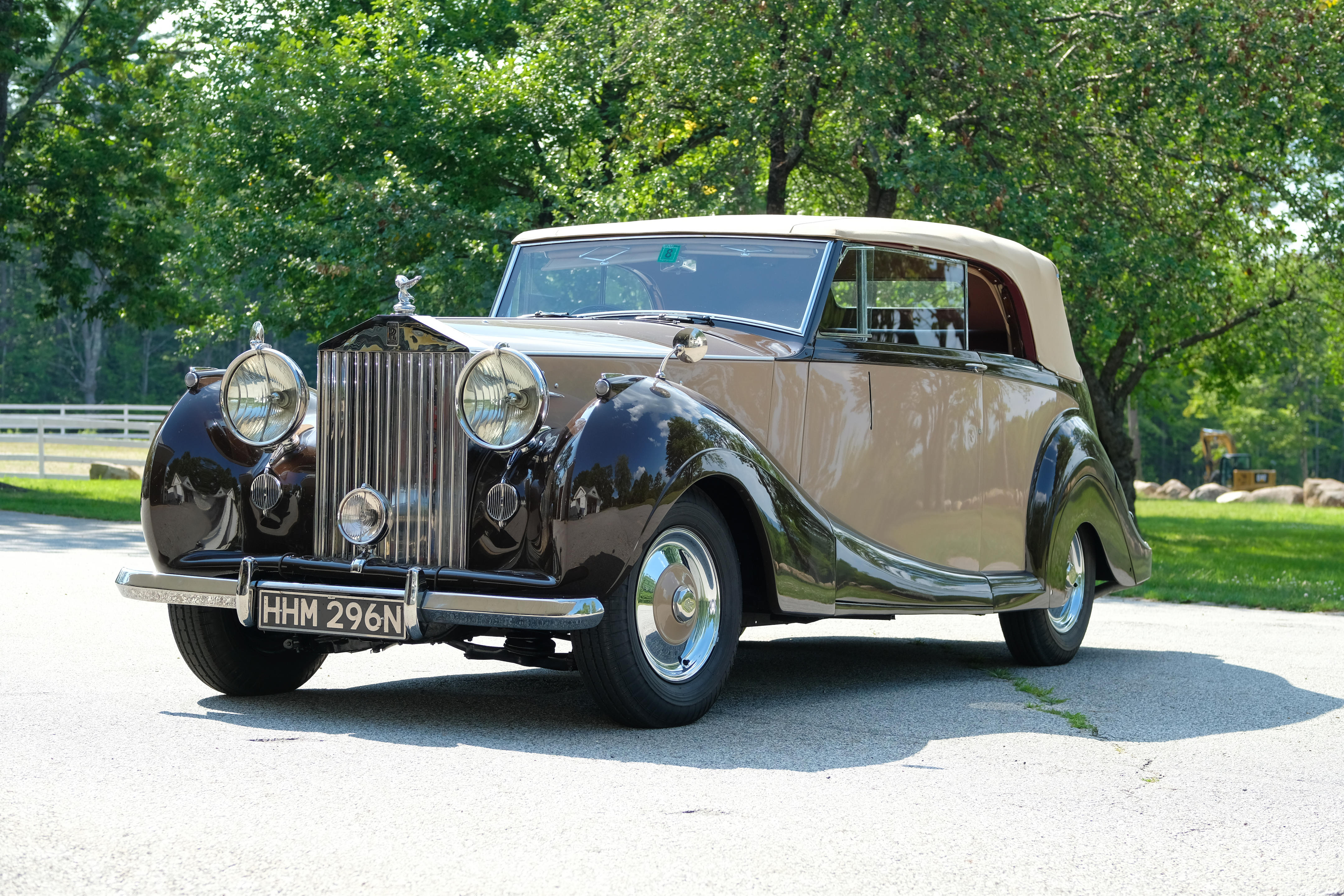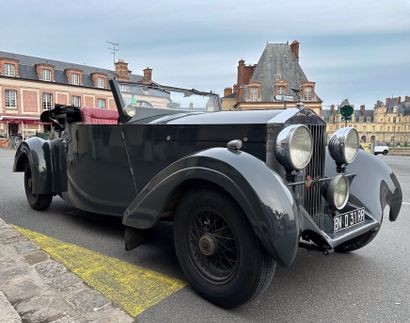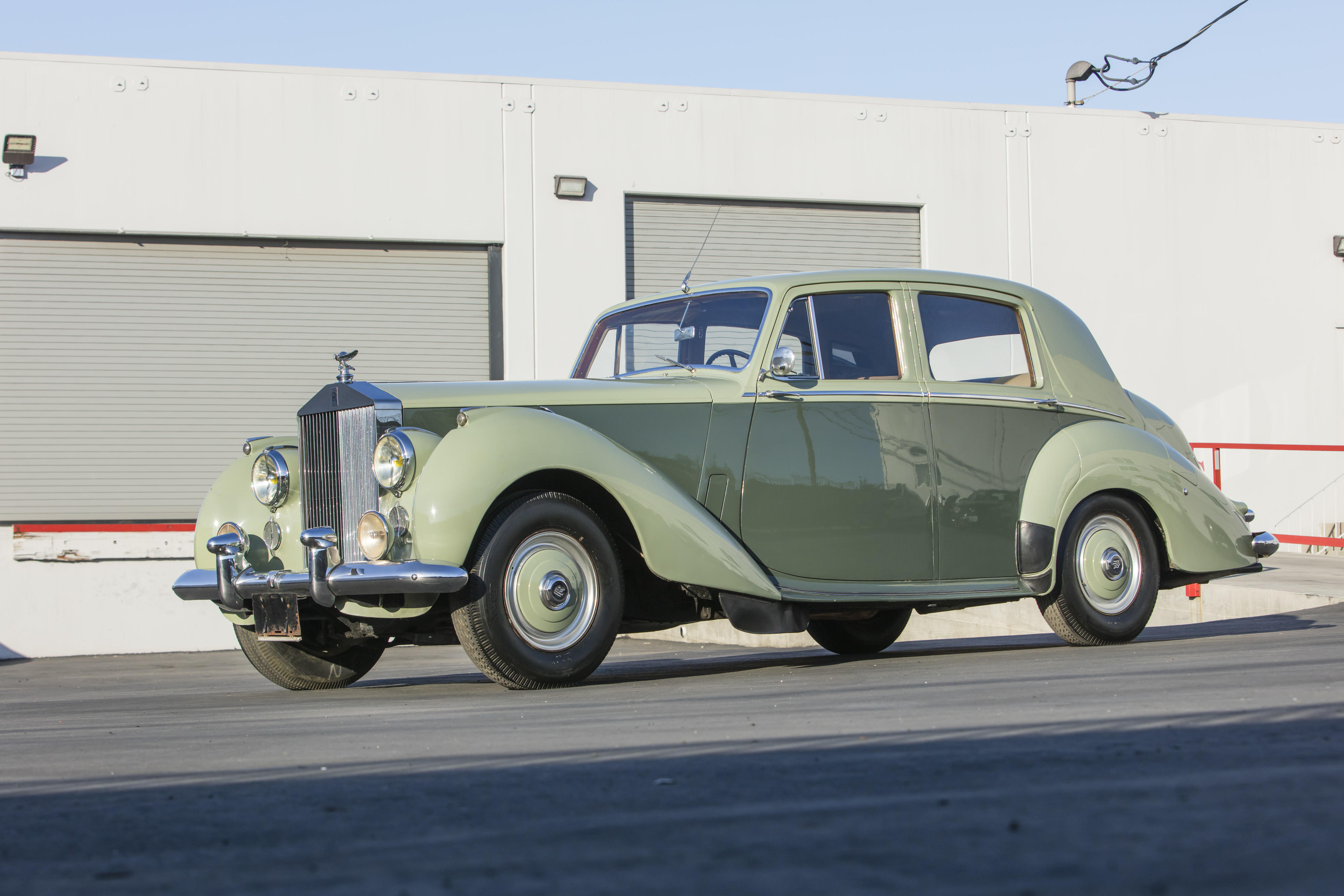4,257cc F-head Inline Six-cylinder Engine Single Dual-choke Stromberg Carburetor 135 bhp 4-Speed Manual Transmission Independent Front Suspension with Coil Springs, Live Rear Axle with Semi-elliptic Springs, Driver-controlled Dampers 4-wheel Hydraulic Drum Brakes *Matching numbers *Documented by the Rolls-Royce Owners' Club Foundation *Restored in 2017 *Featured on the cover of "Rolls-Royce, the Classic Elegance" *Award winner at the 2018 Greenwich Concours d'Elegance Previewing in Uxbridge, Massachusetts by appointment. Please contact motors.us@bonhams.com for scheduling. THE ROLLS-ROYCE SILVER WRAITH The Silver Wraith was the first model offered by Rolls Royce Ltd. after World War II, with production running from 1946 to 1958 at the company's former Merlin engine factory in Crewe. It was also the last Rolls-Royce model that would be delivered in "chassis only" for completion by independent body fabricators. The Silver Wraith thus marked the end of the coach-built Rolls Royce era. In the company's own words, the Silver Wraith was "considered by many to be the most technologically advanced Rolls Royce model in history...an exceptionally graceful and elegant automobile." The Silver Wraith chassis was manufactured in lettered series, "A" through "H" being short-chassis (200 inches on a 127-inch wheelbase) in the late 1940s and "A" through "H" in long-chassis (206 inches on a 133-inch wheelbase) in the 1950s. The shorter version was most suited to close-coupled, or sporting models, open or closed, with the longer chassis better accommodated formal sedans and limousines. Silver Wraiths were built on an improved and strengthened ladder frame, considerably more rigid than its predecessors, and based on that of the pre-war Wraith. The independent front suspension was coil-sprung and the live rear axle was located by semi-elliptic springs. The engine was also based on the pre-war Wraith, utilizing a cylinder head with overhead inlet valves and side exhaust valves. The initial capacity was 4,257 cc and produced 135 horsepower. A dry clutch and a four-speed manual gearbox with column shift sent power to the driving wheels. For the first time, the drum brakes were vacuum-and servo-assisted. Silver Wraiths, as with pre-war models, were delivered as rolling chassis, to be completed by one of a range of select custom coachbuilders to a customer's specification. Not many of those remained after the war, as Rolls-Royce and Bentley were laying plans to standardize their body designs. Still, these independent coachbuilders, whether domestic, Continental, or even American, offered a wide range of bespoke body styles, finishes, and accessories from which a client could choose. THE MOTORCAR OFFERED The handsome example offered here, WFC4, was the fourth in the short-chassis "C" Series manufactured in 1948-1950 and comprising 100 units. In his marque appreciation entitled "Rolls-Royce, the Classic Elegance", Mr. Lawrence Dalton states that WFC4 was among ten short-chassis Wraiths ordered by John "Jack" Barclay Rolls Royce-Bentley of London. These chassis were then sent to either Gurney Nutting and Co. or James Young Ltd. to be clothed in similar very elegant Drop-head coupé bodywork. Reflecting its importance, WFC4 is featured on the cover of Mr. Dalton's tome. Barclay, closely linked to the famous "Bentley Boys", opened as a Bentley dealer in 1927 and a decade later purchased coachbuilder James Young Ltd. At war's end, Barclay expanded with the acquisition of coachbuilder J. Gurney Nutting and Company, with the goal of making roadworthy again as many as possible of the Rolls-Royce and Bentley automobiles that had been laid up in storage during the conflict. Gurney Nutting had developed a well-earned reputation for designing stylish and finely-constructed coachwork and interiors. Gurney Nutting craftsmen also built the famed Le Mans-winning 1929 "Old Number One" Bentley Speed Six and Sir Malcolm Campbell's "Bluebird" land-speed racer of the 1930s.
4,257cc F-head Inline Six-cylinder Engine Single Dual-choke Stromberg Carburetor 135 bhp 4-Speed Manual Transmission Independent Front Suspension with Coil Springs, Live Rear Axle with Semi-elliptic Springs, Driver-controlled Dampers 4-wheel Hydraulic Drum Brakes *Matching numbers *Documented by the Rolls-Royce Owners' Club Foundation *Restored in 2017 *Featured on the cover of "Rolls-Royce, the Classic Elegance" *Award winner at the 2018 Greenwich Concours d'Elegance Previewing in Uxbridge, Massachusetts by appointment. Please contact motors.us@bonhams.com for scheduling. THE ROLLS-ROYCE SILVER WRAITH The Silver Wraith was the first model offered by Rolls Royce Ltd. after World War II, with production running from 1946 to 1958 at the company's former Merlin engine factory in Crewe. It was also the last Rolls-Royce model that would be delivered in "chassis only" for completion by independent body fabricators. The Silver Wraith thus marked the end of the coach-built Rolls Royce era. In the company's own words, the Silver Wraith was "considered by many to be the most technologically advanced Rolls Royce model in history...an exceptionally graceful and elegant automobile." The Silver Wraith chassis was manufactured in lettered series, "A" through "H" being short-chassis (200 inches on a 127-inch wheelbase) in the late 1940s and "A" through "H" in long-chassis (206 inches on a 133-inch wheelbase) in the 1950s. The shorter version was most suited to close-coupled, or sporting models, open or closed, with the longer chassis better accommodated formal sedans and limousines. Silver Wraiths were built on an improved and strengthened ladder frame, considerably more rigid than its predecessors, and based on that of the pre-war Wraith. The independent front suspension was coil-sprung and the live rear axle was located by semi-elliptic springs. The engine was also based on the pre-war Wraith, utilizing a cylinder head with overhead inlet valves and side exhaust valves. The initial capacity was 4,257 cc and produced 135 horsepower. A dry clutch and a four-speed manual gearbox with column shift sent power to the driving wheels. For the first time, the drum brakes were vacuum-and servo-assisted. Silver Wraiths, as with pre-war models, were delivered as rolling chassis, to be completed by one of a range of select custom coachbuilders to a customer's specification. Not many of those remained after the war, as Rolls-Royce and Bentley were laying plans to standardize their body designs. Still, these independent coachbuilders, whether domestic, Continental, or even American, offered a wide range of bespoke body styles, finishes, and accessories from which a client could choose. THE MOTORCAR OFFERED The handsome example offered here, WFC4, was the fourth in the short-chassis "C" Series manufactured in 1948-1950 and comprising 100 units. In his marque appreciation entitled "Rolls-Royce, the Classic Elegance", Mr. Lawrence Dalton states that WFC4 was among ten short-chassis Wraiths ordered by John "Jack" Barclay Rolls Royce-Bentley of London. These chassis were then sent to either Gurney Nutting and Co. or James Young Ltd. to be clothed in similar very elegant Drop-head coupé bodywork. Reflecting its importance, WFC4 is featured on the cover of Mr. Dalton's tome. Barclay, closely linked to the famous "Bentley Boys", opened as a Bentley dealer in 1927 and a decade later purchased coachbuilder James Young Ltd. At war's end, Barclay expanded with the acquisition of coachbuilder J. Gurney Nutting and Company, with the goal of making roadworthy again as many as possible of the Rolls-Royce and Bentley automobiles that had been laid up in storage during the conflict. Gurney Nutting had developed a well-earned reputation for designing stylish and finely-constructed coachwork and interiors. Gurney Nutting craftsmen also built the famed Le Mans-winning 1929 "Old Number One" Bentley Speed Six and Sir Malcolm Campbell's "Bluebird" land-speed racer of the 1930s.














Try LotSearch and its premium features for 7 days - without any costs!
Be notified automatically about new items in upcoming auctions.
Create an alert